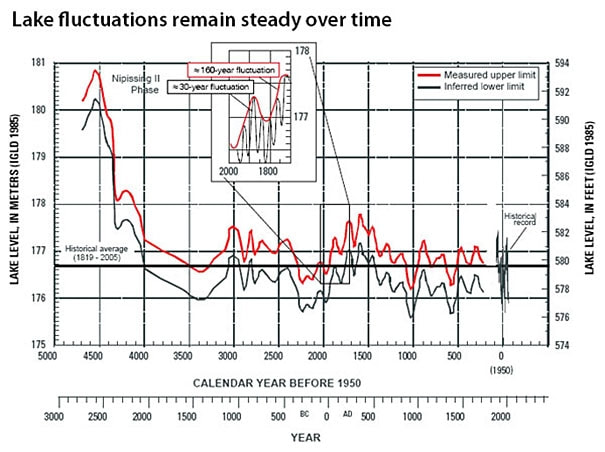Current Water Levels
The U.S. Army Corps of Engineers (USACE) and Environment Canada jointly monitor and forecast water levels on the Great Lakes. Information is compiled and disseminated on the USACE Detroit District website. For the most up-to-date information on current water levels of the Great Lakes, visit the U.S. Army Corps of Engineers website.
Measuring Great Lakes Water Levels
The water levels of the Great Lakes are determined based on a network of water level gages located around each Great Lake. These gages are maintained by the National Ocean Service in the United States and the Canadian Hydrograph Service in Canada. Their locations were selected based on their data record, geography and accessibility. They are spread around each lake in order to provide a lake-wide water surface elevation. The U.S. Army Corps of Engineers (USACE) is responsible for collecting and disseminating information on Great Lakes water levels.
The water levels of the Great Lakes are determined based on a network of water level gages located around each Great Lake. These gages are maintained by the National Ocean Service in the United States and the Canadian Hydrograph Service in Canada. Their locations were selected based on their data record, geography and accessibility. They are spread around each lake in order to provide a lake-wide water surface elevation. The U.S. Army Corps of Engineers (USACE) is responsible for collecting and disseminating information on Great Lakes water levels.
Great Lakes Water Level Gages
Great Lakes water levels are measured from an elevation reference point referred to as the International Great Lakes Datum (IGLD). IGLD consists of benchmarks at various locations on the lakes and St. Lawrence River that roughly coincides with sea level. All water levels are measured in feet or meters above this point. Movement in the earth’s crust necessitate updates to this datum every 25-30 years. The first IGLD was based upon measurements and benchmarks that centered on the year 1955, and it was called IGLD 1955. The most recently updated datum used calculations that center on 1985, and it is called IGLD 1985.
Records are based on monthly average water levels and not daily water levels. In addition to the all-time record lows, each month has a minimum and maximum water level that is reflective of the seasonal fluctuations of the lakes.
Records are based on monthly average water levels and not daily water levels. In addition to the all-time record lows, each month has a minimum and maximum water level that is reflective of the seasonal fluctuations of the lakes.
Historic Water Levels
Water levels around the Great Lakes Basin have been measured since the 1860s. Early measurements were not comprehensive so the official period of records for Great Lakes water levels goes back to 1918.
Water levels around the Great Lakes Basin have been measured since the 1860s. Early measurements were not comprehensive so the official period of records for Great Lakes water levels goes back to 1918.
Since lake levels have been recorded, there has been a general rise and fall of lake levels. However, there is no discernible cycle based upon the U.S. Army Corps of Engineers period of records from 1918-2011.
By studying beach ridges along Lake Michigan, as well as radiocarbon dating of soil core samples, scientists have developed a 4,700 year record of Lake Michigan-Huron water levels. From analyzing this data, scientists identified a general rise and fall cycle that lasts approximately 120-200 years. They also learned that there is a shorter-term fluctuation from 29-38 years (averaging about 32 years) that occurs within the longer cycle.
By studying beach ridges along Lake Michigan, as well as radiocarbon dating of soil core samples, scientists have developed a 4,700 year record of Lake Michigan-Huron water levels. From analyzing this data, scientists identified a general rise and fall cycle that lasts approximately 120-200 years. They also learned that there is a shorter-term fluctuation from 29-38 years (averaging about 32 years) that occurs within the longer cycle.
In general, the Great Lakes system experienced extremely low levels in the late 1920s, mid-1930s, and the mid-1960s. Water levels climbed during the late 1960s and 1970s. Lake levels were above average for some time reaching record highs in the late 1980s. The record high for Lake Michigan-Huron was recorded in October of 1986 at 582.3 feet, IGLD 1985. Between 1999-2014, the lakes experienced an unprecedented period when water levels for Lake Michigan-Huron and Superior fell below their long-term average for 15 years. In January 2013, Lake Michigan-Huron set an all-time record low of 576.02 feet IGLD 1985, surpassing the previous record low of 576.05 feet from March of 1964.
The record low lake level for Lake Michigan-Huron was 576.0, International Great Lakes Datum (IGLD) 1985, in March 1964 (preliminary data indicates we reached a new record low in January 2013) and the record high was 582.3, IGLD 1985, in October 1986. Records are based on monthly average water levels and not daily water levels. In addition to the all-time record lows, each month has a minimum and maximum water level that is reflective of the seasonal fluctuations of the lakes.
Additionally, NOAA Great Lakes Environmental Research Laboratory (GLERL) developed an interactive web-based tool that facilitates the viewing and analysis of monthly and annual lake wide average water level data and forecasts. The tool, the Great Lakes Water Level Dashboard, is intended to improve public understanding of natural Great Lakes water level variability and the inherent uncertainty in model-based water level forecasts. The Great Lakes Water Level Dashboard can be accessed at https://www.glerl.noaa.gov//data/dashboard/GLWLD.html
Future Water Levels
In addition to measuring water levels in the Basin, mathematical relationships have been generated between the measurements of water levels and the rate of flow within the connecting rivers of the Great Lakes system in attempt to predict future water levels. The models are able to generate forecasts of water levels for each lake. However, these forecast models fundamentally depend on accurate seasonal variations of weather patterns. Because there is large variability in weather forecasting, water levels can vary widely from what is predicted.
The United States Army Corps of Engineers (USACE) provides a range for future water levels. This projection is based on the present condition of the lake basin and anticipated future weather. The forecasts fall within the range 90% of the time. However, a significant weather pattern shift can alter lake levels enough for levels to fall outside of the forecasted range. USACE provides Weekly Great Lakes Water Levels information that includes an update on current water levels conditions, weather, and outflows and a forecast of water levels over the upcoming month as well as a Monthly Bulletin of Great Lakes Water Levels which is a six-month forecast of Great Lakes water levels.
These water level forecasts can be accessed at: http://www.lre.usace.army.mil/greatlakes/hh/greatlakeswaterlevels/waterlevelforecasts/
Future Water Levels
In addition to measuring water levels in the Basin, mathematical relationships have been generated between the measurements of water levels and the rate of flow within the connecting rivers of the Great Lakes system in attempt to predict future water levels. The models are able to generate forecasts of water levels for each lake. However, these forecast models fundamentally depend on accurate seasonal variations of weather patterns. Because there is large variability in weather forecasting, water levels can vary widely from what is predicted.
The United States Army Corps of Engineers (USACE) provides a range for future water levels. This projection is based on the present condition of the lake basin and anticipated future weather. The forecasts fall within the range 90% of the time. However, a significant weather pattern shift can alter lake levels enough for levels to fall outside of the forecasted range. USACE provides Weekly Great Lakes Water Levels information that includes an update on current water levels conditions, weather, and outflows and a forecast of water levels over the upcoming month as well as a Monthly Bulletin of Great Lakes Water Levels which is a six-month forecast of Great Lakes water levels.
These water level forecasts can be accessed at: http://www.lre.usace.army.mil/greatlakes/hh/greatlakeswaterlevels/waterlevelforecasts/


